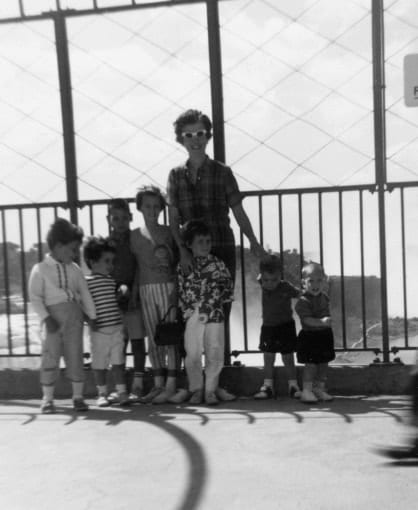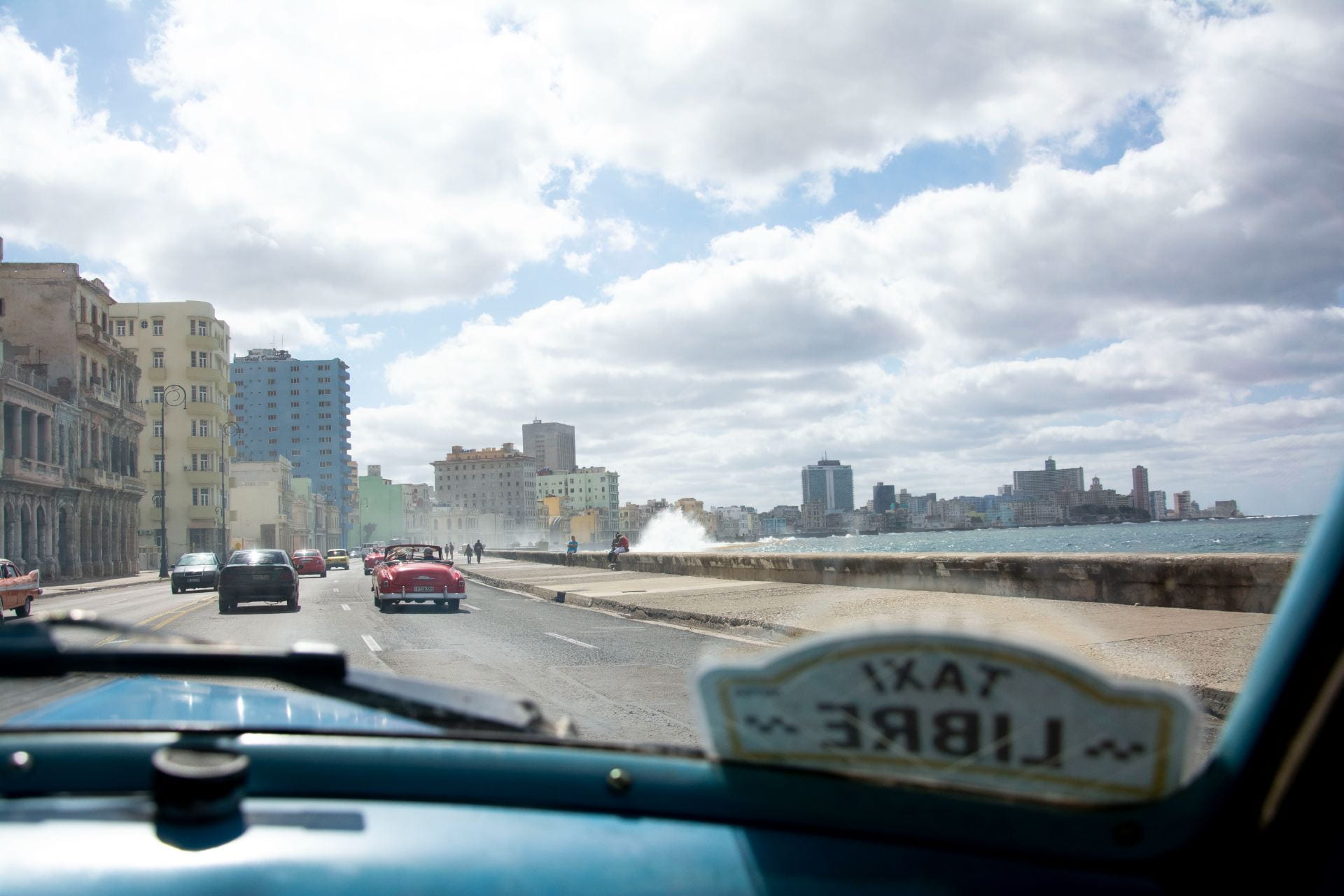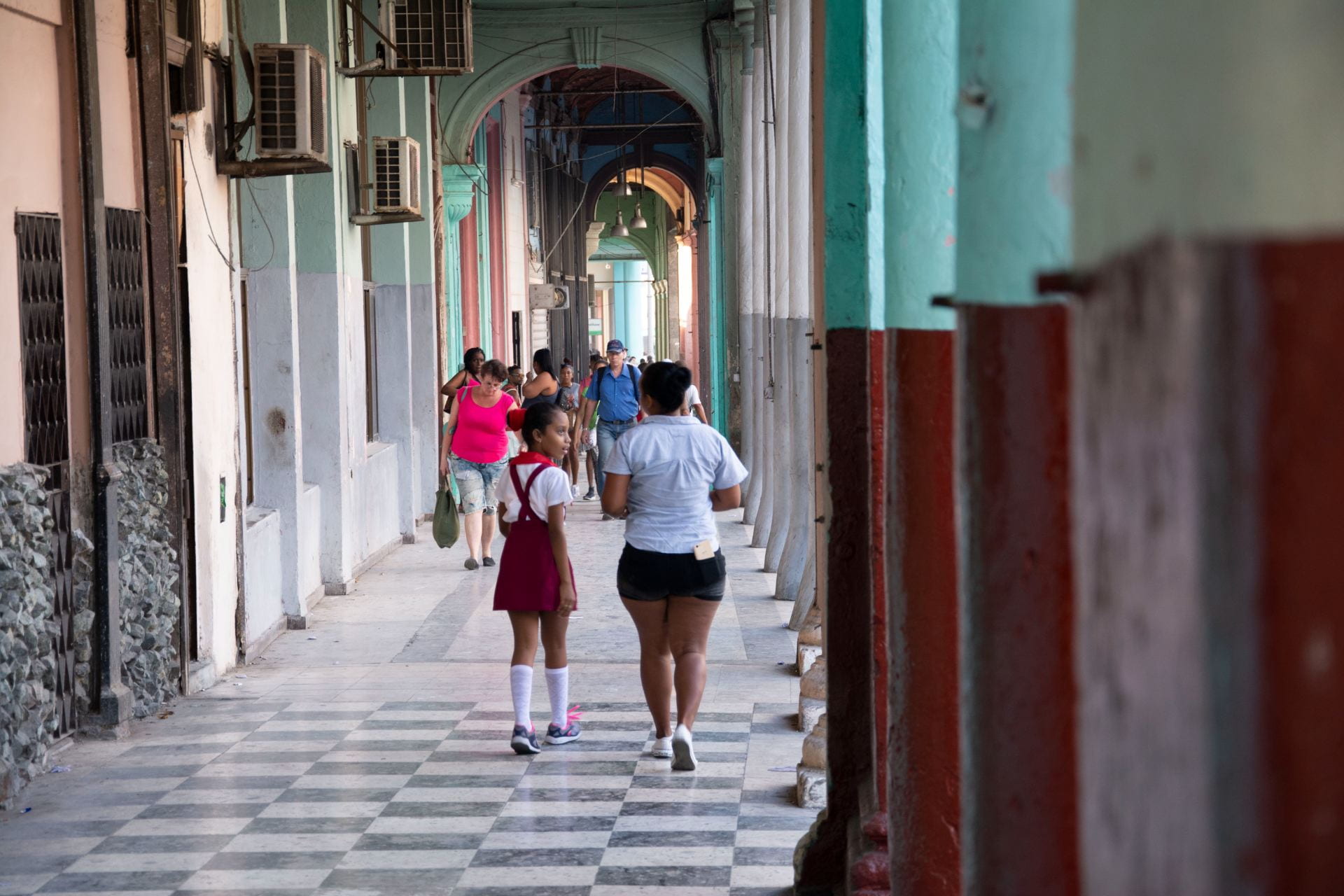60 years later, Cuban children remember when they were forced to leave

Photo by Story Hinckley | Young girls walk home from school March 4, 2019, in the Central Havana neighborhood where Luis Galup lived as a young boy.
By Story Hinckley
BOSTON AND HAVANA, Cuba – Decades later, they still remember the “pecera.” The fishbowl.
They remember being ushered away from their parents with dozens of other children. They remember the room of glass that made a few feet feel like miles. They remember waving goodbye to their parents, unsure of the next time they would meet.
“They separated me from my grandfather and my father, but I could see them,” says Luis Galup, 64, who was 7 years old at the time. “Through the glass, all I could see was my family.”
Mr. Galup is one of more than 14,000 Cuban children who left the island between 1960 and 1962 as part of Operation Pedro Pan: the largest recorded mass exodus of unaccompanied minors in the Western Hemisphere.
When Fidel Castro took over the Cuban government in 1959 with promise of a revolution, many parents feared for their children’s future. In response, and within the greater context of Cold War anxiety, the United States and the Catholic Welfare Bureau, a service branch of the Catholic church in Miami that has since been renamed Catholic Charities, created Operation Pedro Pan. With the approval of the U.S. government, the support of the Catholic church, and the blind eye of the Castro regime, the operation covertly distributed visa waivers and thousands of Cubans between the ages of 6 and 18 filled up the fishbowl before boarding commercial flights out of Havana.
This year marked the 60th anniversary of the Cuban revolution, which had Pedro Pans across the United States thinking back to the country they left behind. President Trump’s approach to family separation at the U.S.-Mexico border as a strategy to deter illegal immigration felt like a situation they remember all too clearly.
“That brought back a lot of memories and made me so angry. I couldn’t believe that,” says Mr. Galup, referring to last year’s reports of children crying for their parents in U.S. detention camps. “I don’t think any children should be separated from their parents like that. I understand what my parents did… But no child should go through this.”
The operation and its current comparisons show the extent of a parent’s love for his or her child, say many Pedro Pans, who are often called Peter Pans in the U.S. Instead of judging these parents, they add, outsiders should understand their sacrifice as well as the dire realities that bring families to these separations in the first place.
“Separating a family, if that’s the only way that the children can have a better life, it’s not always an evil thing,” says Carlos Eire, a professor of history and religion at Yale University, as well as the author of the 2003 book “Waiting for Snow in Havana,” a tribute to his childhood in Cuba. Mr. Eire left with Operation Pedro Pan in 1962 at the age of 11.
“This wasn’t the first time, and it won’t be the last time as we are now seeing, that parents are desperate to get their kids to safety,” says Eire.
They remember
Galup, who now lives in Miami, hasn’t returned to Cuba since he left almost six decades ago. But he still remembers the neighborhood where he grew up, in Central Havana near the Capitol.
He remembers the Ten Cent Galiano store, where he would spend afternoons with his mother as she shopped with their ration card. He would ask his mother for change to ride a stationary carousel horse outside the store. He remembers a nearby park with a big statue. He remembers looking out the window of his family’s apartment at the Malecón, a five-mile roadway along the Havana coast. He remembers walking to the Malecón at night with his grandfather, who would buy them a treat on the way: warm peanuts for himself and a snow cone for his grandson. He remembers riding his bike along the ocean as his grandfather fished off the concrete seawall.
Customers still sit at stools at the Ten Cent Galiano’s long bartop. The park across the street – Parque Fe del Valle – is one of the island’s few free WiFi hotspots. Strangers crowd together on the park’s benches. Many send texts and emails. One man types on a laptop with his face a few inches away from the dirty screen.
Today, the Malecón’s sidewalk looks more worn than the one Galup describes from memory. Years of gusty days, when the salty ocean crashes over the seawall, has eroded the concrete sidewalk. It look porous, like a strip of coral. But the Malecón is still the city’s north star, guiding rusty Chevrolets through rush hour, and calling hopeful fisherman and aimless lovers at night.
Galup says he hasn’t gone back because he remembers what his father said to him before he entered the fishbowl: “‘Son, you’re going to go to a better place than where you live right now. You’ll be going to a different country where you can do and say whatever you want.’”
Why visit Cuba, he says, when his family gave him the opportunity to live in America, with the freedoms the U.S. provides.
“I would love to see where I was born,” says Galup, with a sigh. “But I don’t want to as long as that Communist regime is still there. They separated me from my family.”
Like Galup, Eire has not returned to Cuba since he left as a child. Cuba has banned him, but even if he was allowed to visit, he wouldn’t. To Eire, any tourism money brought to Cuba only further props up the Castro regime. Although Fidel Castro died in 2016, and his brother Raul Castro resigned as president in 2018, many Pedro Pans still see Cuba as an authoritative dictatorship.

My country is destroyed,” says Carmen Romanach, 73, who hasn’t been back since she left as a Pedro Pan at the age of 15. “But Cuba is in my head. It is the best part of who I am.”
Despite their resentment to the Cuban government, many Pedro Pans still celebrate their Cuban identity. As the vice president of the Operation Pedro Pan Group, Ms. Romanach, who now lives in Miami, helps organize an annual meeting of Pedro Pans and monthly breakfasts across Miami. They celebrate the Cuban hero Jose Martí, as well as Our Lady of Charity, the island’s patron saint.
“When we get together, we are like brothers and sisters,” says Ms. Romanach. “We really have a special bond.”
Pedro Pans outside of Miami still find ways to connect with one another, whether it be the Facebook page of Romanach’s group or the Miami Herald’s online database.
They are also quick to point out one another’s successes, to call out the circumstance they collectively overcame. Former Miami Mayor Tomás Regalado is one of us, say Pedro Pans, as is the first Cuban-American U.S. senator, former Florida Sen. Mel Martínez. The president of Miami Dade College, Eduardo José Padrón and Jeff Bezos’ adoptive stepfather, Miguel Bezos, are also Pedro Pans.
It’s this unifying mentality, their clear memory of the fishbowl, that also makes Pedro Pans quick to identify with recent immigration struggles.
“Separation is separation,” says Lily Lorbes, who left Cuba with Operation Pedro Pan in 1961 at the age of 14.
A January report from the inspector general of the US Department of Health and Human Services suggests that thousands more children were separated from their parents at the U.S.-Mexico border under Trump’s “zero-tolerance” policy than the 2,737 recorded in court documents. And the Trump administration announced plans earlier this year to nearly double the capacity of a temporary shelter for migrant minors in Homestead, Florida, already the largest of its kind in the country.
The Homestead camp is less than five miles away from the Florida City camp where Ms. Lorbes was held when she first arrived to the U.S. decades earlier. Where she remembers sleeping on a cot surrounded by strangers.
“This was not an isolated thing,” says Ms. Lorbes, a human resource retiree who lives in Topsfield, Massachusetts. “Parents who can’t leave yet themselves, but see their chance to get their kids out.”
According to data obtained by the New York Times, the number of migrant minors detained at federal shelters hit an all-time high in late 2018 of 12,000–15,000, at least a fivefold increase from 2017.
The Communist realities
Cuban parents didn’t immediately fear for their children’s safety when Fidel Castro first took over in 1959. And neither did the U.S., which still had diplomatic relations with Cuba during the first two years of the revolution. After all, Fidel Castro was promising to bring democracy to an island nation that the U.S. had so long fought to control.
The extent of Castro’s revolution was still unclear at this point, says Victor Triay, a Cuban-American and history professor at Middlesex Community College in Connecticut who is considered an expert on the operation. So although Cubans could visit the still-open U.S. embassy between 1959 and 1960 and apply for a visa, few did. But Monsignor Bryan Walsh, then with the Catholic Welfare Bureau in Miami, realized what was to come in Cuba and he hatched a plan to mass issue student visas to young Cubans who wanted to leave the island.
Then the communist realities of Castro’s proposed democratic revolution started to become clear. Fidel Castro talked about closing schools and employing children in the revolution and more parents started to fear for their children’s safety.
“The revolution was taking over everything very quickly and turning the whole society upside down,” says Ms. Lorbes. “To go away was a risky alternative, but to stay there was also risky.”
The U.S. closed its Havana embassy on Jan. 3, 1961, making Walsh’s student visa plan impossible. But the U.S. still had reason to bring young Cubans to America.
Not only did the United States want to prevent the communist indoctrination of more people amid the global battle of the Cold War, but it also wanted to build a larger base of American allies on the island for pending operations like the Bay of Pigs. Grown Cubans who sympathized with the United States and democracy were more likely to risk their safety for U.S. efforts if they knew their children were safe.
President John F. Kennedy never directly acknowledged the operation, but historians say his administration likely knew about the program and endorsed it. But in February 1961, President Kennedy announced a Cuban Refugee Program, a central goal of which was to help unaccompanied children: “the most defenseless and troubled group among the refugee population.” And in an article Walsh published a decade later, he said Kennedy’s announcement came a few days after he had briefed the administration on his plans.
Walsh even thanked the U.S. government, in a 1990 public letter, for trusting him with a “carte blanche” to bring these children to the U.S. without visas and giving him almost $5 million a year, for six years, to care for them. Triay, who interviewed Walsh before he died in 2001, says that all of Walsh’s actions were supported by the U.S. Central Intelligence Agency.
“The U.S. government approved [the operation]. They helped create it,” says Triay. “The State Department called Walsh in and said, ‘Here. We have an idea for you.’”
And that idea was visa waivers, which Triay refers to as a “legal loophole.” Intended for emergency situations, a visa waiver, when paid for and sponsored by an American, allowed foreigners to come to the United States. Walsh sent several signed visa waivers into Cuba, which were then mass produced underground in Cuba and covertly distributed.
It all happened very quickly and quietly. Jose Ramirez, a Pedro Pan who lives in Westford, Massachusetts, says that friends would simply stop showing up to school. Mr. Ramirez’s parents told him he was leaving for the United States, and a week later he was on a plane.
Many parents, like Ramirez’s, told their children that they were leaving for an academic opportunity in the United States, and that they would see them in a few months. But then Fidel Castro ended commercial flights out of Cuba in October 1962 after the Cuban Missile Crisis, and reunification got more complicated.

Knowledge of – or involvement in – the operation from the Cuban side is unclear.
“It would be astounding if they didn’t know,” says Triay, referring to Fidel and his government, “but we can’t say with certainty that they did.”
Although the operation took place during the first few years of the revolution, when the government’s surveillance program was still developing, it’s unlikely thousands of children left the island amid Fidel’s extensive network of informants. Especially considering the fact that many visa waivers were distributed from a house across the street from the police headquarters, says Eire. And when Eire asked Carlos Franqui, Fidel’s director of propaganda, about the Cuban government’s knowledge and involvement, he responded with a smile.
“‘Anything that would destroy the bourgeois family was wonderful for us,’” Eire recalls Mr. Franqui saying. “They did it on purpose.”
Many of the Cuban families who participated were Catholic and middle class. And the majority of 14,000 children who left – two-thirds by some accounts – were teenage boys, a demographic that could be either advantageous or dangerous to the revolution. During the Freedom Flights of 1965 to 1973 and the Mariel Boatlift of 1980, for example, almost half a million Cubans fled to the United States says Triay, but few of these passengers were teenage boys. Castro rarely let military-age men leave the island.
That’s part of what makes the operation so significant, says Triay. It broke apart families who had reason to oppose Fidel’s government, and like Mao Zedong’s strategy in China, the fledgling communist governments used education to usurp parental authority. The Castro government closed all of the religious, private schools – which often became a central distribution center for visa waivers in their final days.
Eire says 80,000 additional visa waivers were printed and distributed to Cuban children. At least 94,000 Pedro Pans would have left if Castro had not closed the country’s doors.
“That’s how desperate Cuban parents were,” says Eire. “They were not mistaken in panicking.”
“He saved me”
When Galup landed in Florida, Walsh – who continued to manage the operation from Miami – picked him up at the airport. He was then taken to Matecumbe, one of the many camps in south Florida where Pedro Pans stayed until they were picked up by family members or sent to foster homes or orphanages in at least 41 states. With no family in the U.S. to care for him, Galup was soon transferred to the Desmonds, a foster family in Ohio.
When Anne Desmond, now 88, and her husband saw an advertisement in the Catholic Chronicle asking for foster families for Cuban boys, they went to the Catholic Charities building in Toledo and met a handful of boys, including Galup. When they brought Galup home, Ms. Desmond said communicating was impossible: He didn’t speak any English and she didn’t Spanish. But Galup soon became a part of the family, joining her daughter Sharon’s second grade class and forming a particular bond with Desmond.
“I know he missed his parents terribly because he followed me around like crazy at the beginning,” says Desmond, laughing. “He would cry when I went to the grocery store. He would wait for me outside the bathroom door.”
Galup lived with the Desmonds for two years before his grandparents came to the U.S. and brought him to Boston. His parents came about five years after that.
“I remember when I went to Logan Airport to pick them up. My grandfather said, ‘That’s your mom and your dad,’” says Galup, who was 12 years old by then. “My mother said in Spanish, ‘He is a little American’ because I could only speak English.”
Compared to other Pedro Pans, Galup saw his immediate family relatively quickly after coming to the United States.
Eire spent almost four years in camps and foster homes before his mother arrived. Eire never saw his father again, because soon after his father got permission to leave Cuba (14 years after Eire) he passed away. After the camp in Florida City, Lorbes was “shipped out” to a foster family in Albuquerque, where she lived for a few years before reconnecting with family outside of Boston, including her cousin, and fellow Pedro Pan, Jose Ramirez. Mr. Ramirez remembers watching his mother through the fishbowl before he boarded his flight in January, 1961, at the age of 15. He didn’t see his parents again until six years later.
“I remember to this very day, and I’m looking at her right now in my head, my mother’s face,” says Ramirez, as he starts to cry. “The saddest face I have ever seen in my life.”
But family has also been what’s helped Pedro Pans heal from a difficult time in their childhood. When Ramirez went back to Cuba for the first time in 1994, he brought his oldest son who was close to the age that Ramirez was when he left. They visited the school Ramirez had attended in Havana, the church where Ramirez had communion, and the beach where Ramirez swam as a teenager.
“I wasn’t prepared for the emotions,” says Ramirez. “Without my son, I can’t imagine what it would have been like. He saved me.”
